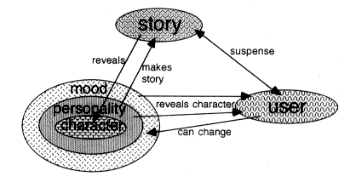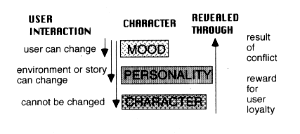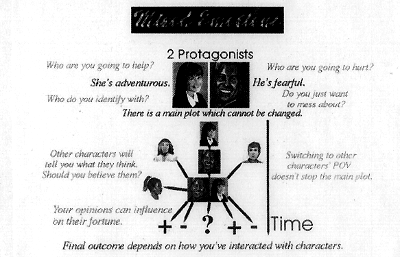 Rosa Freitag,
Rosa Freitag,Dept of Computer related Design, Royal College of Art, London, UK
3D Computer Generated Artlficial Personalities Vs. Real Actors in Video
Abstract
The success of films depends to a great extent on the charisma of character acting. The personal interpretation of text and the nuances of body language which represent the facets of personality and the multiplicity of moods of a human being are characteristics of a good actor.
The Oz Project, at Carnegie Mellon University(1), proposes the construction of artificial characters in an artificial simulated world generated by the computer, codifying personalities and environments. Chris Crawford (2) suggests that all dramatic situations and stories we know should be collected and codified, and that a system be created to place the artificial characters in these situations. As a result the computer would be able to automatically generate the stories and the characters would trigger the occurrence of various-dramatic situations.
At present, technology doesn't allow for the real time generation of 3D graphics that could represent human beings with believable movements. It is even harder to codify narrative and drama, acting and screen presence. Even if in the future this representation is enhanced, I don't believe the emotional engagement of the audience will reach the level of identification achieved with real actors.
Challenging the Oz Project and Crawford's suggestion, I would rather experiment the use of pre recorded video segments with real actors, exploring all alternatives for interactivity which must be pre written in an interactive screenplay.
Interactive characters
A character is a representation of a human being, with her own mood, personality and character. Therefore the user's interaction with characters must simulate real life conflicts. I have elaborated the diagram below to identify opportunities for such interaction.

(Click to enlarge then BACK to return) Mood is influenced by the vagaries of external opinions and circumstances, so the influence of another outside agency on mood (i.e. audience interaction)can be felt to be consistent and natural.
There is a core in the character's personality that can never change. It can only change in moments of crisis, during conflicts in the story. Her deep character is greatly revealed through the personality. Viewers could indirectly cause changes in a character's personality by triggering conflicts in the story, also stimulating the revelation of character.
This deep character must be established by the scriptwriter and cannot be changed by the audience.
The story will be influenced by changes in characters' attitudes, possibly influenced by the audience. The element of suspense will still be present, because viewers cannot control the attitude of a character facing a conflict which requires action dependent on her intrinsic personality.

(Click to enlarge then BACK to return) The result of conflicts could be a reward for "user loyalty". This loyalty is manifested through constant interaction with characters, when the user will progressively understand and perhaps change their personality and attitudes through the story.

(Click to enlarge then BACK to return)
1. Bates, Joseph, The Nature of Characters in Interactive Worlds and The Oz Project, CMU technical note CS-92-200, 1992
2 Crawford, Chris, Interactive Entertainment Design, May 1995
Mixed Emotions - An Interactive Psychological Suspense
MA Interactive Multimedia Royal College of Art
An experiment in interactive storytelling. A short film, using real actors in real backgrounds, with added interactively. Viewers can actively communicate with characters, simulating real life relationships and influencing the story outcomes.
Technology Segments of full motion digital video, Macintosh CD ROM playback engine. Interaction devices: keyboard and mouse or touch screen.
Innovative Aspects There are a number of fake interactive movies on the market. They are just games with some added liner of narrative, or adventure stories with obstacles and puzzles. Mixed Emotions is not a game. It's a fiction film which explores the concepts of non-linear narratives and the viewers' interaction with the characters, allowing a two-way virtual conversation. For this reason it will appeal both for women and men, unlike the adolescent male-oriented interactive games.
Audience: 15+, male and female.
Story line In the middle of the night Susan and Phil hear steps outside the bedroom. Who is there and who does he want? You could help them...or the intruder
Story structure and interactivity The main plot resembles a traditional film structure. If viewers choose not to interact, they will watch a complete linear story, with beginning, middle and end. This will leave a lot of ambiguity, stimulating viewers to play the film again and intersect with characters to explore all sides of the story. The fortune of characters could be changed, so the final outcome will reflect and depend on the interaction.
Interacting with Characters There are two protagonists who will try to convince the viewer to follow the story under their particular point of view. Empathy won't happen because of gender; the strong and opposing personalities and the individual motivations of each character will be the main reasons for identification. Phil is paranoid and tormented by thoughts; Susan is rational and confident about her attitudes. Viewers can switch the "friendship" between the two protagonists and watch the story under the point of view of other characters to get reasons to trust in a character and formulate ideas to help or destroy her plans. The story can be explored in different ways, which could lead to a perfect crime story or a "French style movie about paranoia.
Viewer Roles
1. Guardian Angel/ Evil Corrupter Having a two-way virtual conversation with the characters, you can express opinions, giving positive or negative advice. Characters, like any human being, have their own personality and they might not trust you as a friend. If they trust, they'll follow the advice. Interaction with characters gives access to their thoughts, dreams and desires, resembling a real life relationship.
2. Spectator: switching points of view(POV) While the main plot develops you can watch other characters' points of view. The story will progress following the chosen character's POV. Other characters will try to grab your attention to their opinions about the story and the protagonists, but this will also bring ambiguity. When you are following a character's POV, you'll be missing simultaneous scenes representing the POV of other characters, including the main characters' plot.
For more SYNDICATE SPEAKERS For other SYNDICATES |